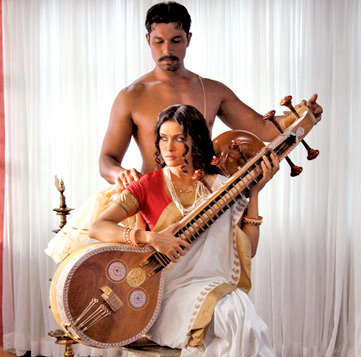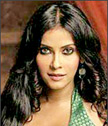|
Glamming up for Galle Film Festival:
Opening Sri Lanka for international films
Sachitra Mahendra and Ruwini Jayawardana in Galle
Galle was Lanka’s most important harbour during Portuguese and Dutch
periods, but faded out when the English built the Colombo harbour.
However the historically and strategically important city attracts
tourists by hordes even now. It is the local city that hosted the first
international literary festival in 2007 and 2008, and now about to see
the first international festival in 2009 - Galle Film Festival (GFF).
The festival will follow the gala fundraiser evenings featuring two
major premieres along with Sri Lankan classical films. Paul Schrader’s
latest film Adam Resurrected was screened on Saturday before last and
Kethan Mehta’s Rang Rasiya (Colours of passion) was screened last
Saturday, with the presence of the director and cast.
 Ketan Mehta’s biopic Rang Rasiya is based on a novel by Ranijth
Desai, who had deconstructed the life-story of a 19th century painter
called Raja Ravi Varma (Randeep Hooda). The film is a chronicle of
cultural dilemmas, political manipulations, professional triumphs, and
personal tragedies woven around Ravi Varma’s life. Ketan Mehta’s biopic Rang Rasiya is based on a novel by Ranijth
Desai, who had deconstructed the life-story of a 19th century painter
called Raja Ravi Varma (Randeep Hooda). The film is a chronicle of
cultural dilemmas, political manipulations, professional triumphs, and
personal tragedies woven around Ravi Varma’s life.
Ravi Varma is a painter who had a strong faith in his own culture
rich with legends. In fact he loved every aspect of his culture, though
sometimes he was mistaken and mistreated by his own culture, for his
ideology on subjects like sex and nudity. For Varma, sex and nudity is a
part of his culture, but it was considered obscene by his society.
He gives a brave speech on obscenity to the court. He distributed his
own paintings of sacred places to his rivals, while he handed his
paintings of ancient nude sculptures to the Judge, who ‘honourably
acquitted’ him later on.
Randeep Hooda’s performance as Raja Ravi Varma is simply excellent
especially with his facial personality in the court scenes.
He shares the ancient legend of Urvashi, who was banished into heaven
once her true form - nakedness - was exposed, with Sugandha (Nandana Sen)
the muse he had met at a temple. The scene of Sugandha exposing her
semi-nudity was aesthetically shot. Ironically Urvashi’s legend repeats
when Varma’s portrait of Sugandha’s semi nudity is exposed. She faces
the conflict of traditional opinion of obscenity and she nearly kills
herself. What she says in the court is remarkably memorable: “This man
turned a woman like me into a goddess, and you turned me into a whore.”
It portrays the two-faced personality of Ravi Varma.
The woman is just another idol for him and he would not care for her
emotions. Sugandha, like Urvashi is banished into heavens after her true
form is exposed - she committed suicide. Ravi Varma’s personality as an
apolitical artiste is well brought out in several stages.
First he was tasked with the job of going to Europe to study
painting, though he bravely stands in his view that traditional India
should be studied more than Europe. The Maharaja is impressed and gives
his consent. Secondly he was invited by a political leader to join his
party, which he declines sarcastically. This made the particular
political leader take Varma to courts charging that he portrayed gods in
humans and obscenity.
|

Ferena Wazier |

Kethan Mehta |

Nandana Sen |
 
Randeep Hooda, Rang Rasiya (Colours of Passion) |
The court scenes show Varma as an old man, though Suganda is left
with her young appearance reminding us Oscar Wilde’s Picture of Dorian
Gray.
Rang Rasiya has superb camera angles, along with excellent
directorial imagination. When Varma and Sugandha are both naked, their
passion is brought to the utmost by the colours on their bodies, which
go along with the central theme. Musically speaking, one line has a
number of melodies, which heightens the movie’s aesthetic beauty.
The key players of Rang Rasiya made their appearance at the Asian
Premiere of the movie. The following are some of the ideas that director
Ketan Mehta, Randeep Hooda, Nandana Sen and Ferena Wazier expressed on
remaking the story of India’s most renowned painter.
Director Mehta
Why did you decide to centre the film on Ravi Varma?
I came across Raja Ravi Varma’s paintings when I was a student at the
Film and Television Institute of India, Pune. I contemplated with the
idea of making a film on him for a long period and it was only after my
previous production, Mangal Pandey that I was given the rights to Ranjit
Desai’s novel, ‘Raja Ravi Varma’. The modern sensibility of Indian art
was pioneered by Varma and the lively colours and striking expressions
of his art captivated me.
I collected facts about him and the more I read the more I was
inspired to do a film of his endeavours. As a film-maker I too suffered
from freedom of express under various censor boards. At such instances
my mind wandered to Varma because not only did he stand for modern art
but he was also a symbol for creative freedom.
Much like Mangal Pandey, Rang Rasiya is based on historical facts.
History is a method of relating incidents with current relevance.
Dramatising a historical character is especially a hard process, which
involves the selection of some events in his life for the film script.
In the selection process, we have to enjoy creative license, which
sometimes may stir controversy and counter certain accepted points of
view. In my case, I don’t care for such issues and timidity is not my
trait.
Randeep Hooda (Raja Ravi Varma)
How did it feel to portray a legendary icon of the past?
Ketan had done a lot of research on the project and I too went
through what he had discovered but frankly, I saw him as a very boring
figure. It seems that once a person passes away people tend to glorify
him or her. No doubt, Varma is a great person but when I built up the
character for the film, I put some of what I have read aside and focused
on what I could put of myself into the role.
I spoke to some of his descendents in Kerela, looked through some
pictures but there were no audio visual slides for me to grade his
personality. Nobody seemed to know what kind of person he was. I had to
mould myself to whatever was in the script and that itself was a
challenge.
How did you become involved in the project?
Mehta’s wife Deepa Sahi, a producer herself, had given him a DVD of
one of my previous movies, ‘D’. He had decided on me for the character,
contacted me and handed me the script. I found it very interesting. I
have done roles like cops and gangsters before but never a painter. I am
very grateful that he put his faith in me.
What is the Indian public’s response to Varma?
Though his art is famous, he himself is fairly unknown. We wish to
shed light on his life through the movie.
What is coming up after Rang Rasiya?
Three more films are slotted for release. There is a film a debut
director titled ‘One who comes in my dream’ which is about a failed
marriage. Then there is one called ‘Love Games’ in which I act the role
of a lost youth in Bombay who ends up having relationships with seven
women. The last in line is a movie named ‘Kusar Prasad’s Ghost’. I
haven’t signed for any new films yet and hope to take a break.
Nandana Sen (Sugandha)
Can you explain how Mehta came across for you?
I am a personal fan of Raja Ravi Varma, and I have his huge paintings
hung in my house. Mehta saw them when he came to my place one day, and
then he asked me for my availability. He was happy because of two
reasons. Firstly I am familiar with the painter, and secondly I look
alike with some of this painter’s portraits. The portrait of Saraswathi
is one example.
One scene exposes your semi nudity. How did you cope with it?
That particular exposing scene is quite essential for the film. This
sensitive scene tells a lot about the painter and his muse. It is
directly linked with a folktale Ravi Varma tells Sugandha, and it is
what happens actually in her real life. Thinking of the aesthetic
requirement, I did not hesitate to perform that scene.
How do you think the Indian public will take it?
Well, the censor board needed to have that particular scene cut. They
in fact sent a notice to Mehta to edit that scene. But Mehta was not
ready to do that, because then he will have to re-do it all over again.
You look much thinner than your character?
(Smiles) According to the script, Sugandha should be a Maharashtrian
woman. Naturally I had to gain more kilos to look a little voluptuous.
Ferena Wazier (Ravi Varma’s friend)
How did you get the chance to take part in Rang Rasiya?
I met Ketan at a function and after flying to London I heard that he
was searching for me to take part in his new film. I returned and took
up his offer on the project.
I play the character of a Parsi journalist who works for the Times of
India. Though you see me in a few scenes in the English dubbed version,
I have a much longer role to perform in the Hindi version. This was my
first film.
What were you involved with before you turned to cinema?
I studied acting for six months at the Royal Academy of Dramatic Arts
(RADA) in London and have done theatre. I have also signed for Soni
Razdan’s next movie ‘Amritsar - A Love Story’ which is based on Manju
Kapur’s novel ‘Difficult Daughters’. |



